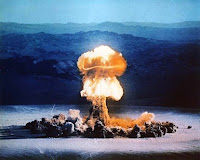
The atomic bomb contains catastrophic energy that is held together by a chain reaction of atoms. When the bomb explodes this energy is released and causing the atoms to split and letting go of the catastrophic energy which has the ability of increasing the temperature up 1,000,000 degrees centigrade. In 1933 a physicist in Hungary named Leo Szilard patented this idea. It may have taking millions of years for us to figure this out, but it just took twelve years from the first public articulation of idea to use the bomb’s first public view to kill enemies in a war. The first time atom was split for energy in 1938, Albert Einstein wrote a letter to Franklin D. Roosevelt suggesting the atomic power could be a major source of energy in the near future. Many scientists thought with this new phenomenon would also lead to the construction of bombs and it’s conceivable, thought much less certain that the extremely powerful bombs of a new type may thus be constructed. One bomb of this type, carried by a boat and which explode in a port, might very well destroy everything in its path and its surroundings. Just one day before the Japanese attacked Pearl Harbor, jumping the U.S into World War 2, Roosevelt made a huge decision to put $2 billion toward the Manhattan Project. This project was designed by a team of the greatest scientists to create the first nuclear weapon. These scientists were charged with developing an A Bomb before the Germans could. Led by General Leslie Groves and theoretical physics J. Robert Oppenheimer, the group included scientific geniuses like Neils Bohr, who fled from Germany to avoid making the bomb for Hitler; Enrico Fermi, credited with creating the first atomic fission reaction; and Richard Feynman, a mathematical savant. With outside help from Einstein, the team was set of to work. The bomb was later completed in 1945.

this a very interseting blog. seem like its going to be lots of fun working on this blog. cant wait til its finish so i could read more bout it.
ReplyDeleteMonte,
ReplyDeleteExcellent work. Your interest in this major event, both a scientific breakthrough and a historical moment, really makes me want to ask you lots of questions. See my comment on your second post.